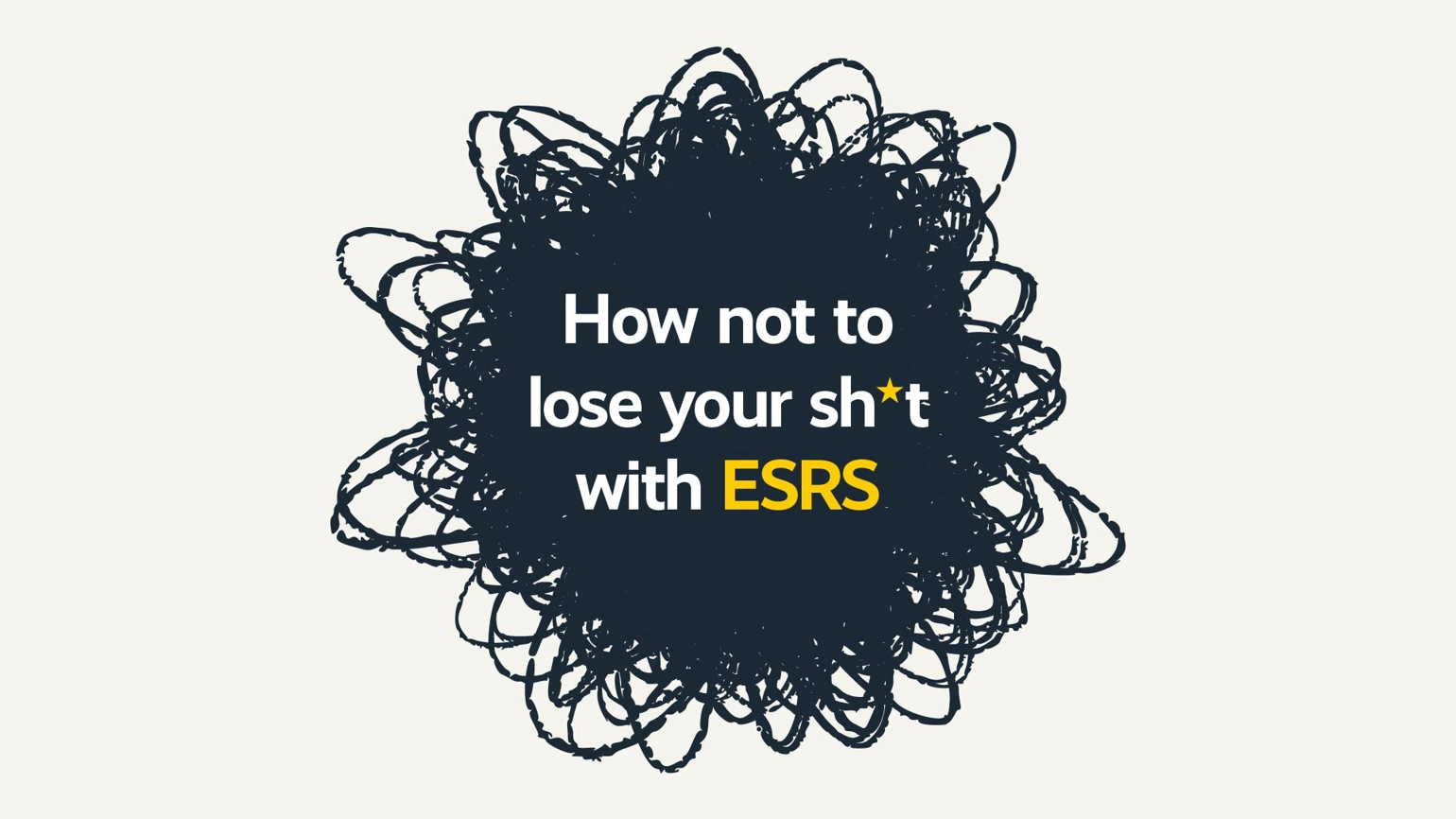Return to journal
How not to lose your sh*t with ESRS
Juliette Child offers her key recommendations to navigate the Standards (while keeping your sanity intact!)

Unsurprisingly the title for this piece came quickly. It’s easy to lose your sh*t when reading through the European Sustainability Reporting Standards (ESRS), before you even start trying to comply with them. Not only are they dense, complex and extensive, they are also written and presented in an ambiguous and incomprehensible way. Talk about making sustainability accessible…
The Standards, which came out in July of 2023, are an important milestone in sustainability reporting. They mark the end of decades of largely voluntary sustainability reporting, with the aim to elevate sustainability to the maturity and rigor of financial disclosure – something that earlier regulation failed to accomplish. On paper, it’s a welcome change. In practice, it’s a whole different story.
If you’re reading this, chances are you’re involved in the reporting cycle of your organisation and have either already lost your sh*t (if so, welcome to the club) or have seen the criticism of the Standards and would like to simply “get on with it”. You might be wondering about the value of spending all this time and money on an elaborate disclosure exercise, rather than focusing on sustainability action (we hear you), or wondering how to maintain focus on the bigger picture, when your resources (and sanity) are being funnelled into an ESRS-sized hole.
If so, you’re in the right place. Having performed a number of CSRD-aligned double materiality assessments and comprehensive ESRS gap analysis exercises for organisations with varying levels of maturity (from those who have decades of reporting experience, to those brand new to it all), we’ve been in the trenches of the Standards. Here, we’ve distilled our key recommendations to help you navigate your way to compliance, while keeping your sanity intact.
Before we begin, a small caveat. While we would love nothing more than to wave a magic wand and simplify it all, the reality is that these Standards are complex and a tick-boxing approach won’t cut it. The aim here is to outline some practical steps that are sure to get you on the right track, avoid some pitfalls and set you up for success.
Overview
- Don’t lose sight of the bigger picture
- Draw on a robust materiality assessment to decide what to report
- Disregard voluntary disclosures, for now
- Lean on the “phase-in” provisions
- Don’t go at it alone
Don’t lose sight of the bigger picture
Believe it or not, the Standards haven’t been introduced to make our lives harder. They serve a purpose and aim to rectify important challenges and barriers in the sustainability landscape.
Underpinning the Corporate Sustainability Reporting Directive (CSRD), the Standards form part of a comprehensive policy package to transform the European Union into a modern and climate neutral economic space. The information provided should enable investors and stakeholders to assess investment risks related to climate change and other sustainability factors, as well as establishing transparency regarding a company's impact on people and the environment.
In particular, ESRS’ focus on ‘impact’ marks a big shift for organisations (although the extent to which they’ve executed this is another story, for another time). Keeping this bigger picture – and the spirit of ‘impact’ front of mind while applying the Standards is our number one piece of advice. It will help you to avoid going down rabbit holes and getting lost in the convoluted language of the requirements.
What’s more, ESRS spells out the underlying objective of each disclosure requirement – you’ll find these outlined directly after the extended title of the requirement (in bold). Ultimately if your disclosure – whether that be qualitative or quantitative – is meeting the objectives, you can’t go far wrong.
Draw on a robust materiality assessment to decide what to report.
Materiality has always been the foundation of effective strategy development and reporting. While the emphasis has shifted towards assessing impact, and the detail and rigor required has significantly increased with the regulation, the underlying purpose of the exercise has remained the same – to help you focus on what matters.
When it comes to ESRS, materiality – if done properly – can be a saving grace. It can ease the reporting burden across several levels.
As outlined on the first page of the Standards, “ESRS do not require undertakings to disclose any information on environmental, social and governance topics covered by ESRS”. The aim is to disclose what is material.
The results of the materiality assessment are used to determine not only the relevant topical standards the organisation should report against, but also understand which of the underlying requirements are relevant. This is an important consideration that often seems to get forgotten, but not surprisingly so.
Because while the concept of materiality is heavily incorporated into the Standards, the architecture of the topical standards don’t lend themselves to its consideration. A substantial number of topics, sub-topics (and sub-tub-topics ) have been squeezed into just ten topical standards, making it quasi-impossible to justify any of these as being immaterial for any organisation. And while we agree that this is a significant disservice from ESRS, materiality outcomes trickle down into the specific requirements themselves – and these ought to be closely examined.
Appendix E of the Standards provides a visual flowchart of how to determine which disclosures to report against. A topic covered by a topical standard may be deemed material, but the associated metrics might not be. In these cases the organisation does not have to report against the requirement or the related datapoint.
Being able to discern whether a metric is ‘material’ requires a detailed and nuanced understanding of your organisation’s impacts, risks and opportunities – all of which should be revealed via the materiality assessment.
Disregard voluntary disclosures, for now.
While we wouldn’t usually advise against going the extra mile, organisations already have their work cut out with the mandatory requirements. Disregarding the voluntary requirements, for now, is a welcome relief.
How can you tell them apart? ESRS uses the terms “shall” and “may” to distinguish between different degrees of obligation on the organisation to disclose information:
“shall disclose” indicates that the provision is prescribed (i.e. mandatory)
“may disclose” indicates voluntary disclosure to encourage good practice
The good news is that there are 279 voluntary datapoints across the Standards (out of over one thousand, but it’s still something!). This was a conscious decision by the European Commission – while the draft standards submitted by EFRAG already included many voluntary datapoints, the Commission further converted a number of the mandatory datapoints to voluntary ones.
Within the detailed ESRS datapoints implementation guidance (which you can find here), the voluntary datapoints are marked in orange across the Excel file. Ignoring these in the initial years of compliance could help you to focus time and energy on what matters most.
Lean on the “phase-in” provisions.
Similar to turning a number of mandatory datapoints into voluntary ones, the Commission introduced additional phase-in provisions for some reporting requirements. Essentially, certain requirements have been postponed by one or two years, giving organisations more time to prepare and therefore lowering the initial barrier to reporting.
As stated by the Commission, “the additional phase-ins focus on those reporting requirements considered more challenging for companies”. A full overview of the phased-in disclosure requirements can be found in Appendix C of ESRS 1. They focus on two key areas: reporting on anticipated financial effects, and workforce-related datapoints.
In their first reporting year, organisations are allowed to skip reporting on anticipated financial effects from all climate and other environment-related impacts, risks, and opportunities. They’ll be able to ease into their disclosures on anticipated financial effects to qualitative disclosures for the first three years of reporting.
Furthermore, selected disclosure requirements and datapoints included in ESRS S1 Own workforce (one of the largest topical standards) can be omitted for the first reporting year. These are related to social protection, employees with disabilities, health and safety, and work-life balance, among others.
While these disclosures will become mandatory, putting them in the backburner will allow you to focus on the more pressing mandatory disclosures.
Don’t go at it alone.
For far too long sustainability has been siloed with selected individuals and departments. And while the phrase “sustainability is integrated into everything we do” is often splattered across company comms, it rarely holds true.
With ESRS, those days are over. Key parts of the business will need to be brought onboard and we’re already witnessing new alliances being formed. As part of the double materiality projects we’ve undertaken, we’ve brought together sustainability, strategy, finance, risk and investor relations teams within our clients’ organisations to assess the financial impact of sustainability-related risks and opportunities, alongside existing thresholds and approaches to risk management. These collaborations are paving the way to a smoother compliance journey.
Beyond materiality, the wealth of new information and data required can only be unlocked through collaboration between various functions including HR, procurement, accounting, investor relations, just to name a few. So, if you haven’t done so already, initiating internal conversations across the company is a must.
Critically you’ll need to engage senior leadership and the Board to ensure accountability and that the right resources are unlocked to reach compliance – and that shouldn’t be underestimated. This includes the costs of collecting and verifying sustainability new data, updating internal systems and processes, and engaging with stakeholders on sustainability matters.
Convening workshops with relevant stakeholder groups is a great way to upskill and divvy up responsibility – making sure everyone is pulling up their sleeves and working towards the same goal.
Still feeling overwhelmed?
That’s normal. ESRS are part of wholescale changes being applied to the regulatory landscape - getting a grip on it all is no small feat. While we hope that this piece will enable some of you to (hopefully) not lose your sh*t, we empathise with those wanting an ally to help navigate the way.
If you're looking to explore key anti-greenwashing legislations and principles to avoid greenwashing download our "How to Avoid Greenwashing: Our 4 Principles - Guidebook".
If you’re interested to learn more or are looking for some guidance and support as you embark on your double materiality assessment, ESRS-aligned reporting or wider communications, get in touch at [email protected].
